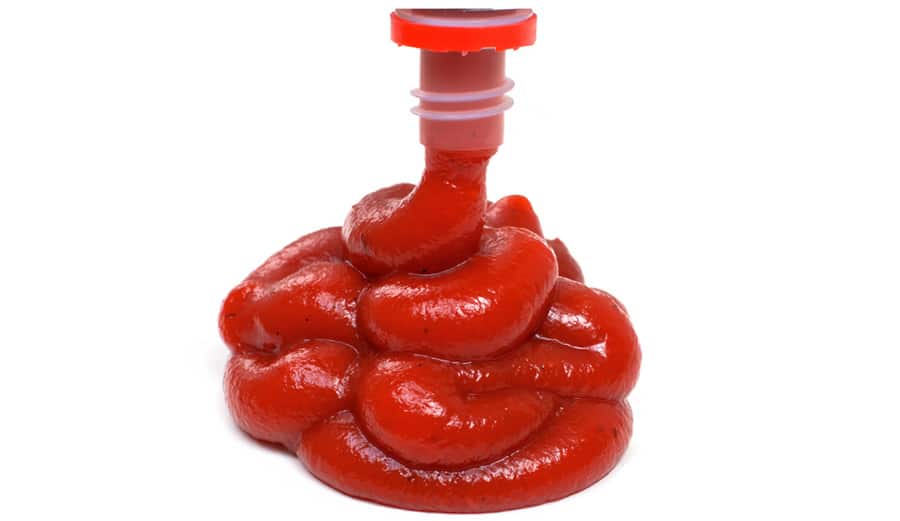You need to attach two pieces of wood together for your latest woodworking project. What should you reach for, the wood glue or the wood filler? What is the difference between wood glue and wood filler?
The differences between wood glue and wood filler are as follows:
- Wood glue can adhere wood together while wood filler cannot
- Wood glue is often weatherproof while wood filler is not
- Wood glue usually has some form of UV resistance but wood filler will dry up and crack if it’s exposed to the sun
- Wood filler has wood fibers in it and wood glue does not
- Wood filler is more adept at filling in gaps and holes than wood glue
- Wood filler always dries clear, which is not exclusively the case for wood glue
Ahead, I will clearly explain what wood glue and wood filler are as well as their differences. I’ll also discuss when to use each product and whether you can swap out wood glue for wood filler and vice-versa. You’re not going to want to miss it!
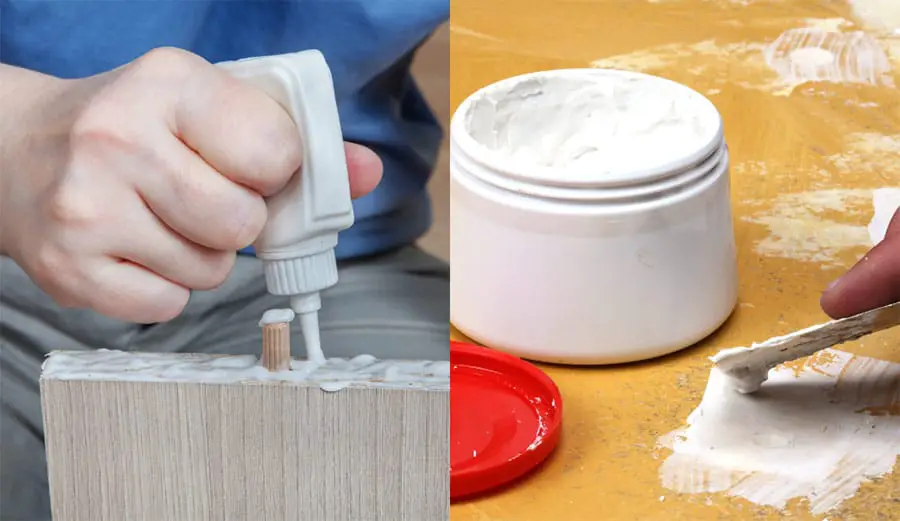
What Is Wood Glue?
First, let’s begin with a definition of wood glue. As the name tells you, wood glue is an adhesive that will stick two pieces of wood together.
Like wood fillers, some types of wood glue are designed to fill in holes and gaps as well. It is easy to see why beginner woodworkers sometimes get these two products mixed up.
Depending on the type of job, you can shop for a variety of wood glue types. These include aliphatic resin glue, polyvinyl acetate, cyanoacrylate, polyurethane, resorcinol-formaldehyde resin glue, and urea-formaldehyde resin glue.
Yes they are big names, but I will explain what each of them is below.
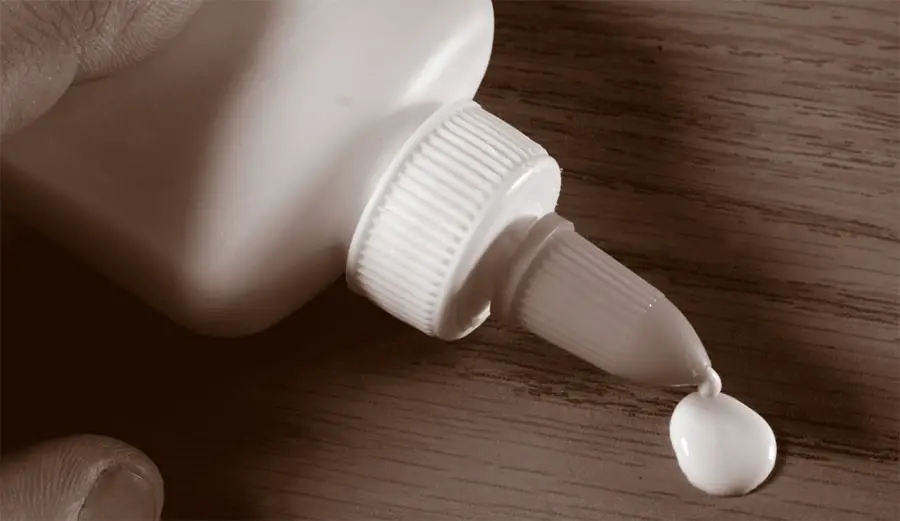
Aliphatic Resin Glue
The first type of glue, aliphatic resin, is a pretty common one. Also referred to more simply by names such as yellow glue or carpenter’s glue, aliphatic resin uses an aliphatic compound to adhere to wood.
The reason it’s nicknamed yellow glue is that aliphatic resin dries yellow with a creamy, almost soft texture.
If you’re shopping for an aliphatic resin glue, some common brands are Lepage and Titebond. Unlike white household glue like Elmer’s which slips or creeps while you hold the glued items together, aliphatic resin creeps far less.
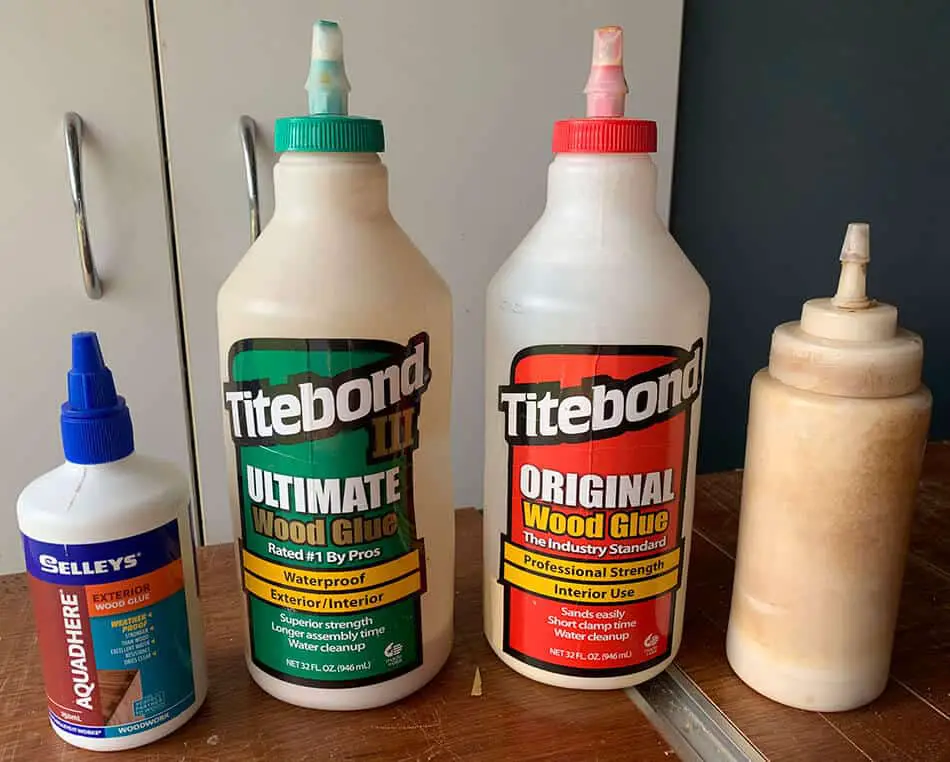
It also sets quickly at temperatures of 50 to 110 degrees Fahrenheit (10°- 43° Celcius). That said, it’s not recommended you use aliphatic resin glue outdoors, which is rare for wood glue. Click here to see what happens when wood glue freezes!
The consistency of this glue is thick, but it doesn’t drip much. Aliphatic resin is also great at resisting water and heat, and it can withstand some moisture as well. Its bonding strength is good but not the best, but it isn’t flammable and it hardly smells.
Ahead of curing your aliphatic resin glue, make sure you use tap water to clean it. Also, if you have globs of glue on your woodworking project that you don’t want, you need to sand these. Putting wood stain on the glue will not absorb in that area, which will make your project look bad.
Polyvinyl Acetate
Another option you have is polyvinyl acetate, but admittedly, this doesn’t come very highly recommended. That’s because polyvinyl acetate or PVA glue is simply craft and hobby glue. It’s the white glue we talked about in the last section. PVA glue is prone to creeping, but it does dry fast and it’s completely non-toxic.
If you ever use PVA glue and then decide to switch to another type of wood glue, the second type of glue won’t adhere to the PVA once it dries. Even PVA glue can’t adhere to dried PVA glue, which puts you in a tight situation.
Cyanoacrylate
Cyanoacrylate is known more popularly as superglue or crazy glue, which indicates its bonding abilities. This adhesive comes from esters such as ethyl cyanoacrylate. Woodturners and other woodworkers rely on cyanoacrylate for making minor repairs to a project.
If you make models made of balsa wood, cyanoacrylate is a favorite wood glue for this hobby as well. That’s due to how strong this glue is compared to balsa wood.
You’re only supposed to use a little bit of cyanoacrylate at a time, as overdoing it can make your bond weaker instead of stronger. Yet using too little glue also hurts the strength of the bond, so it’s a fine balancing act.
It doesn’t help that cyanoacrylate is already prone to brittleness. If you glue several pieces of wood with cyanoacrylate and then days or weeks later go to bend one piece of wood, the glue could crack and come undone.
You don’t get a strong odor when working with cyanoacrylate, which is definitely one perk. Cyanoacrylate also won’t polymerize quickly compared to some other wood glues. The glue itself can be leaky and runny, so if you want to use cyanoacrylate to fill a wood hole, get the gel variety instead.
Do be careful to avoid contact with the skin, as cyanoacrylate will stick to any exposed skin. Also, it dries immediately, so you could theoretically get your fingers stuck together if you misuse the glue.
Polyurethane
Excel and Gorilla Glue are two popular wood glue brands that are polyurethane-based. Besides just wood, this type of glue can also adhere to rubber, ceramics, sand, glass, plastic, metal, and textile fibers. It’s quite versatile then.
Polyurethane glue doesn’t bond the best, but it can work in a pinch.
Resorcinol-Formaldehyde Resin Glue
Bonding far better than polyurethane glue is resorcinol-formaldehyde resin glue. It can withstand ultraviolet immersion as well as high levels of exposure to fungi, mold, solvents, salt water, mild acids, and boiling water.
You can’t just use this glue right out of the package though. Instead, it requires mixing with a powdered catalyst and liquid resin to work.
Resorcinol-formaldehyde resin glue dries purple, so you have to be careful about leaving residue behind. It’s not the best to breathe in either, so you absolutely need adequate ventilation when using this type of glue.
Urea-Formaldehyde Resin Glue
In a similar vein is urea-formaldehyde resin glue. Urea-formaldehyde or urea-methanal is a resin that yes, does come from urine. If you can get past that, you’ll find that this wood glue doesn’t leave purple residue behind like resorcinol-formaldehyde glue does.
It also won’t become abrasive, it can cure in cooler temps, it’s not very expensive, and it won’t creep much. It’s long been the top wood glue choice for assembling wooden airplanes too.
What Is Wood Filler?
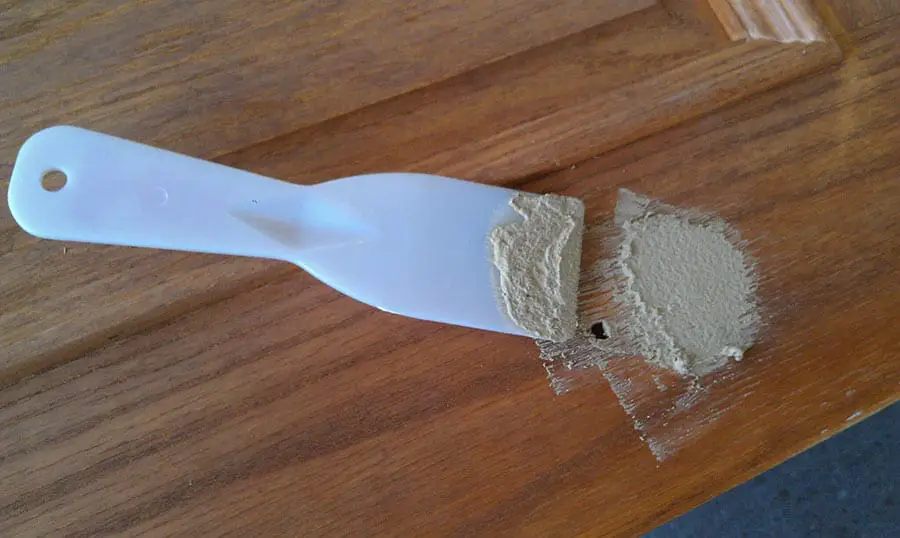
Next, let’s discuss wood filler. If you have dents, chips, or holes from nails in your wood, wood filler can repair these, smoothing them out. This product can also seep into open-grained wood pores.
If you often work with mahogany or oak then, wood filler is especially useful.
You do have to choose between one type of wood filler or another. If your wood filler is supposed to fill in wood pores, then it will be a lot less thick than wood filler for filling in gaps. The former has a pancake batter-like texture and the latter is heavier and almost like putty.
However, wood filler and wood putty are not the same. They get confused for one another a lot, even more than wood glue and wood filler, but these are two different products.
Click here to see my comparison between wood putty and wood filler. The key difference is in the ingredients.
Wood putty has a base made of polyurethane, fiberglass, epoxy, or plastic whereas wood filler includes a binder with wood fibers or sawdust. Also, once you apply a wood filler, it will eventually harden or cure. Wood putty never cures, so you can’t use it in lieu of wood filler.
Famowood is an example of a wood filler. This product includes wood flour, or particles of wood ground down to a flour-like texture. Famowood also contains a nitrocellulose lacquer that acts as a binder. This wood filler brand and others like it work on a variety of wood species. It causes some shrinkage but not much, and it dries relatively fast.
Some wood fillers do have putty in them, such as Wunderfil. If you need a thinner wood filler for smoothing out wood grains, you simply mix in some water and use this wood filler for that purpose.
Otherwise, right out of the container, a dual-purpose wood filler like Wunderfil is supposed to be used for filling in gaps and holes in your wood. Thinner wood fillers may have varnish or oil in them if they don’t contain water.
Whether you want your wood filler thicker or thinner, most are available in a variety of natural wood colors meant to blend right into the wood you’re working with. Many fillers will dry without leaving colored residue behind as well. Some even have a glossy finish that’s quite appealing!
See if wood filler can hold a screw?
What Are the Differences Between Wood Glue and Wood Filler?
Now that you’re clearer on what wood glue and filler are, let’s elaborate more on the differences between the two that we touched on in the intro.
Wood Glue Is For Adhering, Wood Filler Is Not
Wood glue can admittedly be dual-purposed, as we discussed before since some varieties can fill gaps. For the most part though, if you’re going to use wood glue, it’s for adhering parts of wood together.
Wood filler cannot do that. Sure, it can patch over the quality of uneven, holey wood, but it can’t attach that wood to another piece.
Even if you used wood putty–which, to reiterate, is not wood filler–it’s tackier, sure, but it’s not wood glue.
Wood Glue Is Weatherproof, Wood Filler Isn’t
Wood glue has a greater degree of waterproofing for outdoor use than wood filler. Since you can mix many wood fillers with water to thin the consistency, you are indeed allowed to use water with wood filler. However, it’s not tested for submersion like wood glue often is.
You’re better off putting a project secured with wood glue outdoors than one finished with wood filler. Your project will especially hold up well in the rain if you used wood glue since lots of glues are waterproof and weatherproof.
Wood Glue Has UV Resistance, Wood Filler Does Not
Another difference between wood glue and wood filler is UV resistance. Wood fillers are great at what they’re designed to do, but if you leave wood treated with a filler outdoors for too long, bad things can happen.
The dried wood filler can dry out, even more, becoming brittle and cracking. This can seriously affect the look of your finished woodworking project.
Many types of wood glue are resistant to UVA and UVB rays. If you’re making something like a wood bench for the yard then, you want wood glue.
Wood Filler Includes Wood Fibers, Wood Glue Does Not
What separates wood filler from wood putty is the inclusion of wood fibers, sometimes even wood flour. Yet for as many types of wood glue as there are out there to buy, none have wood fibers in them.
A discontinued type of wood glue known as casein glue contained phosphoproteins like what you’d find in dairy products, but no wood grains.
Wood Filler Often Fills in Holes and Gaps Better Than Wood Glue

Like we’ve discussed, if you absolutely had to fill in a gap with wood glue, you could try and it might even work. It just as easily could not.
The problem with a lot of wood glues is they can cover a gap when wet, but as they dry, the glue soaks into the wood. Those glues that can fill a gap may not be very structurally sound, at least compared to wood filler.
If you have an epoxy resin glue, what some woodworkers opt to do is use structural fillers to make the resin even thicker and heavier. Although the resin works more like a wood filler at this point, you have to go through a lot of trouble to get there. It’s much easier to buy wood filler and save your time and money.
Remember, wood filler is made exclusively for filling in gaps, even very tiny ones in wood grains. It will do its job much better than wood glue.
Wood Filler Dries Clear, Wood Glue Doesn’t Always
You have to be careful about which type of glue you use for your woodworking projects. Polyvinyl acetate can leave white residue behind while aliphatic resin dries yellow. The most noticeable by far is resorcinol-formaldehyde resin glue, which comes out purple and dries in that hue as well.
Wood filler dries clear and in a color that closely mimics the original hue of the wood. No one will ever know you used it.
Conclusion
Wood glue and wood filler are two different products that don’t really work well when used interchangeably. You can rely on wood glue to adhere pieces of wood together, often with different levels of bonding strength depending on the variety of glue you use. Some wood glues can fill in gaps in the wood, but typically not very well.
Wood filler is intended for smoothing gaps and filling in spaces between wood grains in some types of wood like mahogany. Unlike wood putty, wood filler dries hard. It also contains wood fibers in the formula.
Ideally, you should have both wood glue and wood filler handy in your workshop so you can use either product when the need arises. Best of luck!

